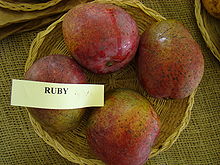Ruby (mango)

The 'Ruby' mango is a named mango cultivar that originated in south Florida and is known for its bright red color.
History
The original 'Ruby' tree was grown from a seed on the property of Ed P. Davis in Miami, Florida. It was named in 1948, when it was first evaluated by the variety committee of the Florida Mango Forum, and first propagated by Davis the same year[1]. In the decades following, the parentage of the 'Ruby' was unknown but recent pedigree analysis estimates that the 'Ruby' likely had 'Haden' in its parentage.[2]
'Ruby' would never be heavily propagated in the state, but two grafted trees were planted at the University of Florida's Tropical Research and Education Center, as well as the USDA's National Clonal Repository in Miami. From these locations bud wood for the 'Ruby' was sent to different countries for commercial evaluation.[3] It is now grown on some commercial scale in Africa.[4]
Description
The fruit are oblong in shape and small at maturity, averaging under a pound in weight. They develop a brilliant crimson blush covering most of the fruit. The yellow flesh has minimal fiber and rich and spicy sweet flavor with a strong aroma. 'Ruby' contains a monoembryonic seed and the fruit are often born in clusters. The fruit typically mature from July to August in Florida.
'Ruby' trees are moderately vigorous growers, developing large, upright, and open canopies[5].
References
- ^ http://www.fshs.org/Proceedings/Password%20Protected/1954%20Vol.%2067/284-290%20%28LEDIN%29.pdf
- ^ http://www.crec.ifas.ufl.edu/academics/faculty/burns/pdf/192-197.pdf
- ^ http://www.fshs.org/Proceedings/Password%20Protected/1992%20Vol.%20105/278-280%20%28CAMPBELL%29.pdf
- ^ http://www.cirad.bf/doc/mouche2_09.pdf
- ^ Campbell, Richard J. (1992). A Guide to Mangos in Florida. Fairchild Tropical Garden. p. 147. ISBN 0-9632264-0-1.
{{cite book}}:|access-date=requires|url=(help); Cite has empty unknown parameter:|coauthors=(help)

